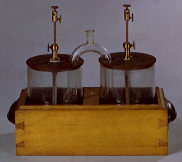
25.4 x 13.6 x 32
Glass, zinc, copper, brass and wood
CAT. 1878 : 436
Pilha de taças.
Cup battery.
One of the disadvantages of the early voltaic piles lay in the fact that stacking the different elements produced a strong pressure on the lower elements (see instrument 135). To resolve this problem Volta developed a new system using several glass cups containing acidified water and two kinds of electrodes, zinc and copper.
The cup battery model in the Gabinete de Física in Coimbra is composed of two cylindrical cups in a wooden box. Each cup has a lid with a brass rod passing through it. Inside one of the cups is a copper plate and in the other, a zinc plate. Both plates are submerged in an acid solution.
Electrical contact between the two elements is achieved by means of a glass tube in the shape of an inverted U, filled with the same acid solution as is in the two recipients. The tube has an opening at the top, which may be closed by a cork. When the cork is removed, the level of the solution in the tube goes down, interrupting the electrical circuit between the two elements. This configuration enables the teacher to show the existence of an electric current within electrochemical batteries. When the two half-batteries are connected by means of an electrical insulator, no current is seen in the circuit.